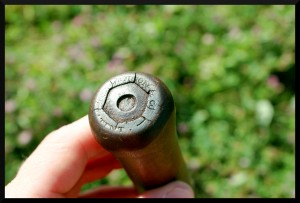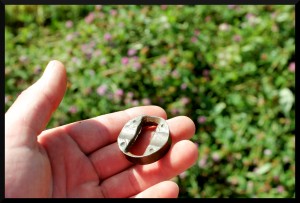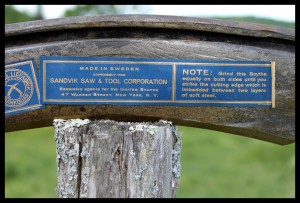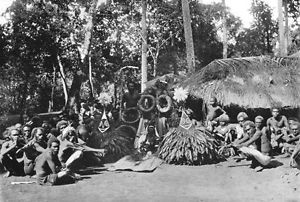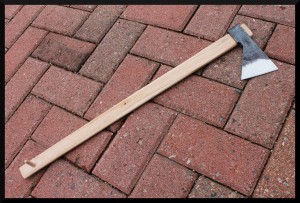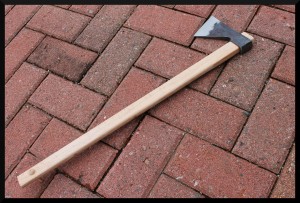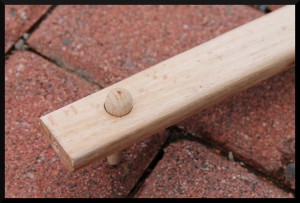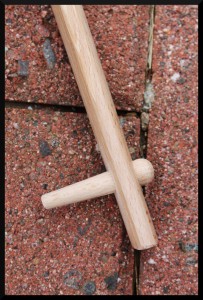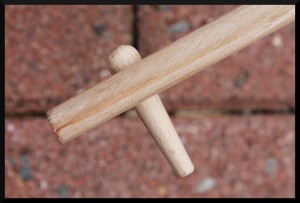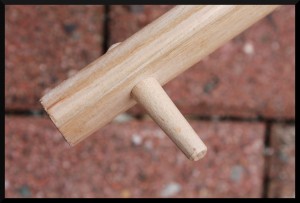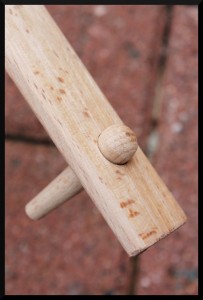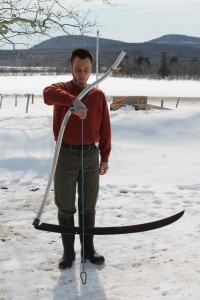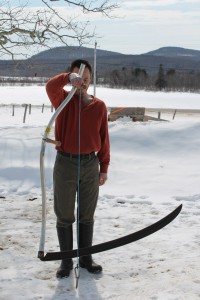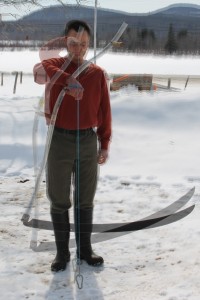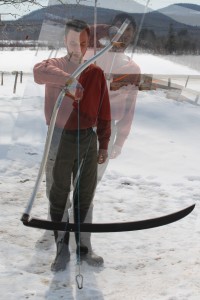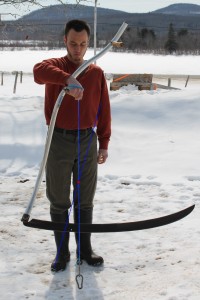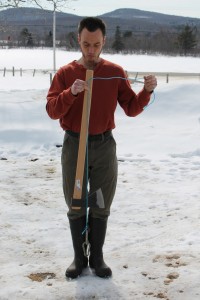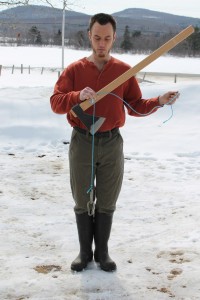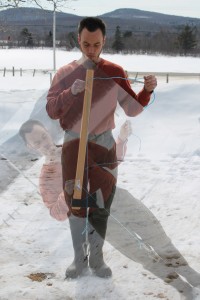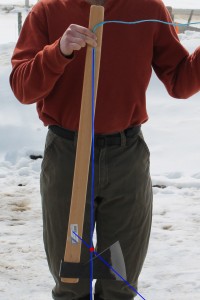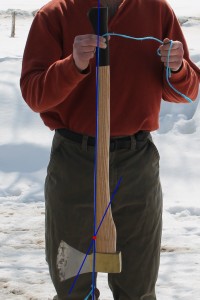NOTE: This is a living document and will see continued updates and adjustments as time permits.
Of all aspects of axes, one of the most-touted but least-understood concepts is how they balance. One often hears that an axe has “good balance” or “bad balance”, but what does that actually mean? Ultimately, all axes are balanced, but the question lies in how that balance impacts the orientation of the handle and the bit in use.
Shown here is a comparative analysis of a classic American style axe (a Council Tools Velvicut 4lb American Felling Axe) alongside two 1300g (2.89lb) Italian axes by Rinaldi: a Calabria and Trento pattern respectively. The grip point on the handle is represented by a blue dot, the center of gravity by a green dot, and the axle as the red line running through them.
The axle is the axis through which the tool will naturally balance and rotate from, and is always represented as a direct line running from the grip point (wherever that may be) through the center of gravity. When the center of gravity lies external to the body of the object, it can be easily found by suspending the object by two different points along with a plumb line. The object will automatically pivot at the grip point to bring the tool into balance. Make mental note of the position of the plumb line, and grip the tool from another point and take a reading of the plumb line again. Where the two plumb lines would intersect in space is the location of the center of gravity. Knowing these dynamics, it is possible to easily analyze any axe without the need to know specific weights or using formulas or computation of any kind.
When people talk about long bits having head wobble (see Cook et al.) they usually make the mistake of measuring from the eye, when really they should be measuring from the axle. As a result, the influence of bit length is often greatly exaggerated, especially when combined with misunderstandings of the effects of curved vs. straight handles.

Having a deep bit allows for deep notches without glancing your cheeks and minimizes risk of barking the neck of your handle against the mouth of the notch. However, it tends to move the handle off a single axis, and so one must be more mindful of which hand is delivering force and how when grasping under the head before a swing, since it creates a plane (triangulation) rather than a simple line. This can be easily compensated for in technique, but one must be aware of it, and ideally one would make a handle with an offset neck to bring as much of the handle as possible along a single axis. Many shipwright’s adzes exhibit just such a neck offset because their manner of use (a third class lever) made it necessary for clean results. This requires starting with a large piece of wood with good grain orientation to be sufficiently strong, and so more commonly one finds axes with relatively straight handles, even with curved American handles.
Note that many American axes could also do with a little more offset in the neck, and that with off-axis handles a change in the grip point will change the presentation of the bit relative to the stroke. This can actually be used to advantage in certain situations. Gripping higher on the handle will yield an axle that presents the bit more open during the stroke, while gripping it lower will present the bit at a more closed angle.
A Calabria and Velvicut axe with the handles altered for ideal offset.
As another way of phrasing the dynamic, imagine you lopped off the rear face of a sledge hammer to reduce its weight, which leaves the eye now at the rear of the head. It would then need the forward face’s angle adjusted slightly to close its presentation to the target and an offset handle to give it the same handling characteristics it had before (though now with less weight.)
Now that we’ve seen how that dynamic plays out, let’s examine how changing different variables impacts the axle, location of the center of gravity, and orientation of the bit.
In the upper left we have an axe or hatchet of fairly conventional orientation and balance, with a short handle. As before, the grip point is shown in blue, the center of gravity in green, and the axle in red. However, we’ve now added the line running between the heel and toe of the bit in fuchsia to help with visualizing the orientation of the bit with the axle.
In the top center, the bit orientation and grip point are held constant, but the bit has been extended. This shifts the center of gravity forward, which pivots the axle forward along with it. In the top right we have the same extended bit, but the grip point has been changed. Because the extension of the bit took the handle more off-axis, the new axle leads to a more open presentation of the bit. The axe has been rotated to put the axle in vertical orientation to highlight this. If, when the bit was lengthened, the handle had been offset to lay along a single axle, the change in grip point would not have resulted in any change in presentation.
In the bottom left, the axe is identical to the one in the top left, but the handle has been extended, effectively closing the presentation of the bit in use despite the head not having been altered in any way. Lastly, in the bottom center and right the heel of the blade has been moved out and then inward respectively.
Lastly, to illustrate that axes with offset necks are not just some theoretical armchair speculation, here are some actual examples of American axe heads fitted to properly offset handles, image courtesy of Axes by G-pig, and used with permission:
Manufacturing such handles on a mass scale, however, would require much larger pieces of wood for blanks, and most axes that have handmade handles running off-axis are generally made that way because it is more expedient and convenient, or possibly because the maker did not even understand these principles and so did not even realize that an offset would be of benefit.
Fortunately, most axes with off-axis handles have a wide enough neck to provide counter-leverage during the two handed span hold. This counter leverage is only needed for a brief moment at the start of the stroke, and is thereafter unnecessary as the hands converge to a practically singular grip point and a natural balance is almost immediately restored. An offset handle, in most instances, merely allows good technique to not require so much mindfulness and is more automatic or “fool-proof”.
The above show the axle of the tool (red line) and corresponding lever arms (blue lines in center figure) of the tool when used with a sliding upper hand (numbered green dots) and fixed lower hand (blue dot.) As previously, the red dot shows the center of gravity, and when the axle and handle diverge the axis along which the hand is sliding is shown by a green line.
On the left you can see that the axe head is balanced by its large poll, and so a straight handle is an appropriate match, with no imbalances imparting torque on the hand in horizontal blows.
The middle axe has the same profile, but the eye has been shifted to the far rear, causing the center of gravity to shift forward in response. This now causes the handle to run off-axis and we can see the lever arms imparting torque on the axle at different points along its length as the upper hand position changes during a sliding stroke. As the hands converge we can see that the lever arm gets shorter and shorter until it becomes essentially insignificant. As such, the infamous “wobble” of a poll-less axe is mostly imparted at the beginning of the stroke, and–while not the ideal–if bearing this in mind it can be compensated for in technique by applying appropriate counter-torque at the start of the stroke and making the slide as early in the stroke as possible.
The third axe now shows the poll-less head with the handle corrected to bring the main length back along a unified axle. This axe will afford the bit size-to-head-weight advantages of a poll-less axe with mostly equal balance to the polled version. One will note that while the axe will now balance properly, the upper hand cannot go as high on the handle as the straight one without running off-axis again. The handle also is trickier to make than in the case of the other two examples and requires better grain alignment to minimize runout.
In case the previous diagrams have been a little difficult to visualize, this diagram simplifies the relationship by eliminating complicating factors. Rather than an “axe” shaped head, we have a simple long, eyeless bar as if the handle were welded to the solid head. The top view shows us the forces at work when the axe is held horizontal. The intersection of the handle’s trajectory and the centerline of the head is shown by the red circle, and the handle treated as massless. A triangle is placed at the point of rotation to indicate the fulcrum forced by the two-point grip. The two sides of this “teeter-totter” are colored to assist in seeing their relative length, and the lines are copied and shown below the head for a clearer comparison.
In the first figure we see a balanced “T” shape, with mass being equally distributed to either side of the center of gravity, and the handle running directly towards it. This tool is in perfect rotational balance.
In the second figure, the handle has been shifted to one side and the lever arms are now imbalanced, causing the longer end to want to drop. The hollow magenta circle marks the center of gravity and the dotted line indicates where the axe would be rotating from if held by the bottom hand only. With the second hand in play, the forced axle of the red line is where the axe will rotate when held/suspended loosely. However, torque applied along the red line will cause the tool to attempt to rotate around the natural axle of the dotted line.
In the third figure, the handle is now offset to align the handle with the natural axle. The red dotted line shows where the handle had previously run in the second figure. The lever arms are now brought back into balance and the “teeter-totter” is now equalled out again.


























































